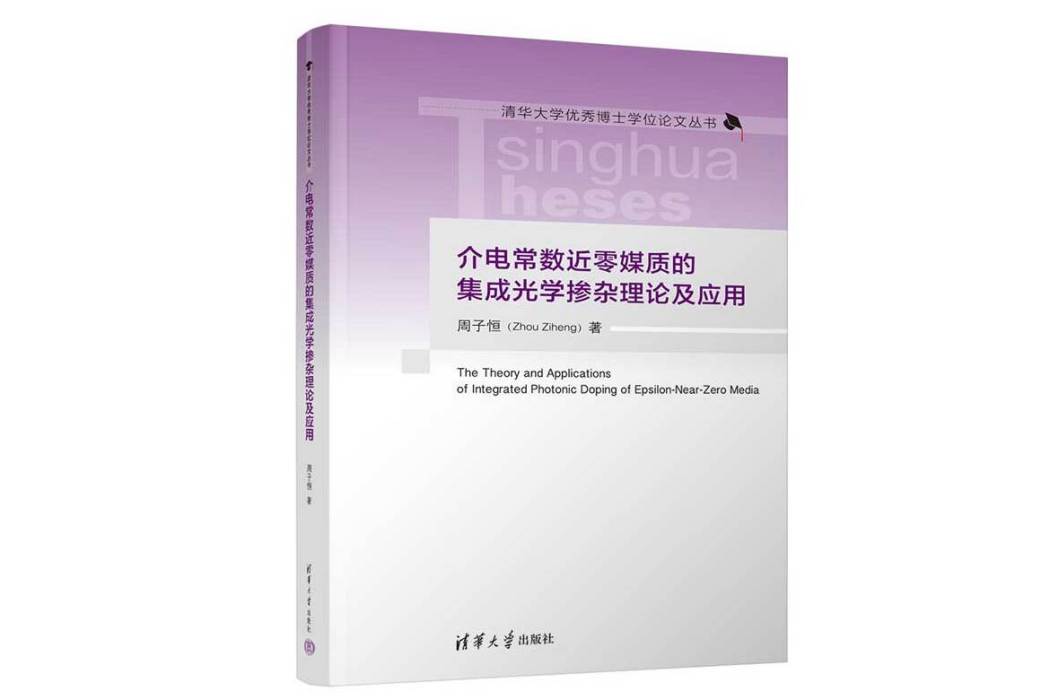《介電常數近零媒質的集成光學摻雜理論及套用》是2023年清華大學出版社出版的圖書,作者是周子恆。
基本介紹
- 中文名:介電常數近零媒質的集成光學摻雜理論及套用
- 作者:周子恆
- 出版時間:2023年12月1日
- 出版社:清華大學出版社
- ISBN:9787302644392
- 定價:79 元
內容簡介,圖書目錄,
內容簡介
《介電常數近零媒質的集成光學摻雜理論及套用》針對介電常數近零(ENZ)媒質及其光學摻雜調控展開研究,介紹了集成化、低損耗的ENZ媒質及光學摻雜的理論與實現方案,並基於近零折射率特性與光學摻雜電磁調控給出一系列電路與天線領域的關鍵套用。《介電常數近零媒質的集成光學摻雜理論及套用》的內容可以總結為如下三個方面。①基礎理論與平台方面:闡述了集成光學摻雜的理論,可解決近零折射率媒質與光學摻雜的損耗問題與平面集成困難。②工程套用方面:介紹了基於集成光學摻雜的電路與天線套用,將近零折射率媒質的獨特性質與集成光學摻雜的高效電磁調控引入工程實踐,在器件的幾何結構靈活性、功能可操控性上相較於傳統設計有質的提升。③理論與套用的進一步拓展:將光學摻雜理論從單一摻雜異質體情形拓展至多摻雜異質體情形,闡述了色散編碼的理論與套用,介紹了與單元排布無關的超構媒質新範式。
圖書目錄
目錄
第1章緒論
1.1研究背景及意義
1.2近零折射率媒質
1.2.1媒質及超構媒質的分類
1.2.2近零折射率媒質基礎特性
1.2.3近零折射率實現方案及套用
1.3光學摻雜概念及特性
1.4波導與基片集成波導
1.5本書研究內容
第2章集成光學摻雜理論
2.1集成光學摻雜基本概念
2.2磁導率調控理論
2.3光學摻雜局域場增強效應
2.4集成光學摻雜實驗驗證
2.5本章小結
第3章集成光學摻雜的電路套用
3.1引言
3.2可任意彎折的波導傳輸線
3.3基於光學摻雜的ENZ元件及匹配電路
3.3.1ENZ元件的集總模型
3.3.2基於ENZ元件的廣義匹配電路
3.4基於光學摻雜的ENZ功分網路
3.4.1任意幾何的N連線埠ENZ網路理論
3.4.28路均等分的功分器設計
3.4.310路非均等分的功分器設計
3.4.4實物加工測試與討論
3.5本章小結
第4章集成光學摻雜的天線套用
4.1引言
4.2波導等效ENZ天線的基本形式及特性
4.2.1天線結構及工作模式
4.2.2可獨立操控的輻射方向圖與工作頻率
4.2.3天線加工及測試
4.3水平全向高增益ENZ天線設計
4.3.1天線結構與工作原理
4.3.2天線加工及測試
4.4光學摻雜的波導等效ENZ天線
4.4.1天線結構與工作原理
4.4.2天線加工及測試
4.5本章小結
第5章多摻雜異質體理論及套用
5.1引言
5.2多摻雜異質體無耦合效應
5.3數值仿真及實驗驗證
5.4多摻雜異質體的色散編碼套用
5.5本章小結
第6章總結與展望
6.1本書工作創新點
6.2未來工作展望
參考文獻
在學期間完成的相關學術成果
致謝
CONTENTS
Chapter 1Introduction
1.1Research background and significance
1.2Near-zero-index media
1.2.1Classification of material and metamaterial
1.2.2Fundamental property of near-zero-index media
1.2.3Realization schemes and applications of near-zero index
1.3Concept and property of photonic doping
1.4Waveguide and substrate-integrated waveguide
1.5Main research subject of this book
Chapter 2Theory of substrate-integrated photonic doping
2.1Concept of substrate-integrated photonic doping
2.2Theory for magnetic permeability manipulation
2.3Local enhancement of magnetic field for photonic doping
2.4Experimental verification of substrate-integrated photonic doping
2.5Summary of this chapter
Chapter 3Application of substrate-integrated photonic doping in circuitry
3.1Introduction
3.2Arbitrarily bendable waveguide transmission line
3.3ENZ element and impedance matching circuits based on photonic doping
3.3.1Lump model for the ENZ element
3.3.2Impedance matching circuits based on ENZ elements
3.4ENZ power dividing network based on photonic doping
3.4.1Theory of arbitrarily-shaped N-port ENZ network
3.4.2Design of 8-branch equal-split power divider
3.4.3Design of 10-branch unequal-split power divider
3.4.4Prototype fabrication and measurement
3.5Summary of this chapter
Chapter 4Application of substrate integrated-photonic doping in antenna
4.1Introduction
4.2Basic form of waveguide-based ENZ antenna and properties
4.2.1Antenna structure and operating mode
4.2.2Independently controlable radiation pattern and operating frequency
4.2.3Antenna fabrication and measurement
4.3Omnidirectional high-gain ENZ antenna
4.3.1Antenna structure and operating principle
4.3.2Antenna fabrication and measurement
4.4Waveguide-based ENZ antenna with photonic doping
4.4.1Antenna structure and operating principle
4.4.2Antenna fabrication and measurement
4.5Summary of this chapter
Chapter 5Theory and application for multiple photonic dopants
5.1Introduction
5.2Noninteracting effect of multiple photonic dopants
5.3Numerical simulation and experimental validation
5.4Application of dispersion coding via multiple photonic dopants
5.5Summary of this chapter
Chapter 6Conclusion and outlook
6.1Innovations of the research works in this book
6.2Outlook for future research
References
Academic achievements
Acknowledgements

